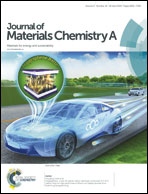Defects lead to a massive enhancement in the UV-Vis-IR driven thermocatalytic activity of Co3O4 mesoporous nanorods†
Abstract
A sample of Co3O4 mesoporous nanorods (Co3O4-MNR) with a considerable number of Co2+ vacancy defects was prepared by a facile method. Co3O4-MNR exhibits highly effective photothermocatalytic activity and excellent durability for the gas-phase oxidation of benzene (a recalcitrant poisonous air pollutant) under UV-visible-infrared illumination from a Xe lamp. It is discovered for the first time that the presence of Co2+ vacancies in Co3O4-MNR massively enhances the photothermocatalytic activity of Co3O4. Compared to a commercial Co3O4 sample (Aladdin) with a smaller number of Co2+ vacancies and TiO2 (P25), the CO2 production rate of Co3O4-MNR is massively increased by 165 and 309 times, respectively. Co3O4-MNR exhibits efficient photothermocatalytic activity for benzene oxidation even under the visible-infrared illumination of λ > 690 nm. The catalytic oxidation of benzene on Co3O4-MNR under the illumination of the Xe lamp follows a mechanism of solar-light-driven thermocatalysis. The experimental evidence of CO-TPR as well as theoretical evidence of density functional theory (DFT) calculations demonstrate that the presence of Co2+ vacancies in Co3O4-MNR significantly increases the activity of the lattice oxygen in Co3O4, thus massively promoting the thermocatalytic activity of Co3O4. Interestingly, a novel photoactivation on Co3O4, quite different from the conventional photocatalysis of semiconductor photocatalysts such as TiO2, is discovered to considerably increase the solar-light-driven thermocatalytic activity of Co3O4-MNR. By combining the experimental evidence of isotope labeling, CO-TPR, and FTIR with the DFT calculations, we obtain a deep insight into the novel photoactivation: the illumination from the Xe lamp enhances the activity of the lattice oxygen in Co3O4-MNR, thus considerably promoting the solar-light-driven thermocatalytic activity of Co3O4-MNR.



 Please wait while we load your content...
Please wait while we load your content...